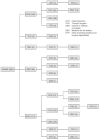Lung cancer referral patterns in the former Yorkshire region of the UK
- PMID: 11857009
- PMCID: PMC2746535
- DOI: 10.1038/sj.bjc.6600029
Lung cancer referral patterns in the former Yorkshire region of the UK
Abstract
The purpose of this study was to find out what proportion of patients are referred as lung cancer guidelines assume, whether different referral pathways result in different management and what proportion of patients are seen within recommended time intervals between referral and treatment. A randomly selected sample of 400 lung cancer cases registered with the former Yorkshire Cancer Registry database in 1993 was selected for casenote analysis. Mode of presentation, speciality of initial referral, treatment by specialist, time intervals for key points in the referral pathways were analyzed. A total of 362 (90.5%) of case-notes were available. Less than half of lung cancer patients (173, 47.8%) presented to hospital with a chest X-ray diagnosis of lung cancer. Forty-one (11.3%) presented as self-referrals to Accident and Emergency and the remainder were referred without a diagnosis of lung cancer by other routes, mainly via GPs. Patients who did not present initially with a lung cancer diagnosis were less likely to receive specialist care (62%:96%), or have their diagnosis histologically confirmed (57.1%:80.3%) or receive surgery or radical radiotherapy (6.9%:13.9%). Nine per cent of all 362 patients did not receive a specialist opinion. Eighty per cent of patients referred by a GP with CXR suspected lung cancer were seen at hospital within 2 weeks. Only 32.4% of those receiving active treatment were treated within 8 weeks of clinical diagnosis or first hospital visit. Lung cancer patients presenting to hospital without a suspicious CXR are less likely to have specialist care, histological confirmation of their cancer and have lower rates of active treatment (surgery, any radiotherapy or chemotherapy).
Figures
References
-
- Cancer Outcomes Monitoring1999Cancer treatment policies and their effects on survival: Lung. Key sites study 2NYCRIS. (available at www. nycris.org.uk)
-
- Cancer Outcomes Monitoring2000Lung Cancer Referral Patterns: The Yorkshire ExperienceNYCRIS(available at www.nycris.org.uk)
MeSH terms
LinkOut - more resources
Full Text Sources
Medical



